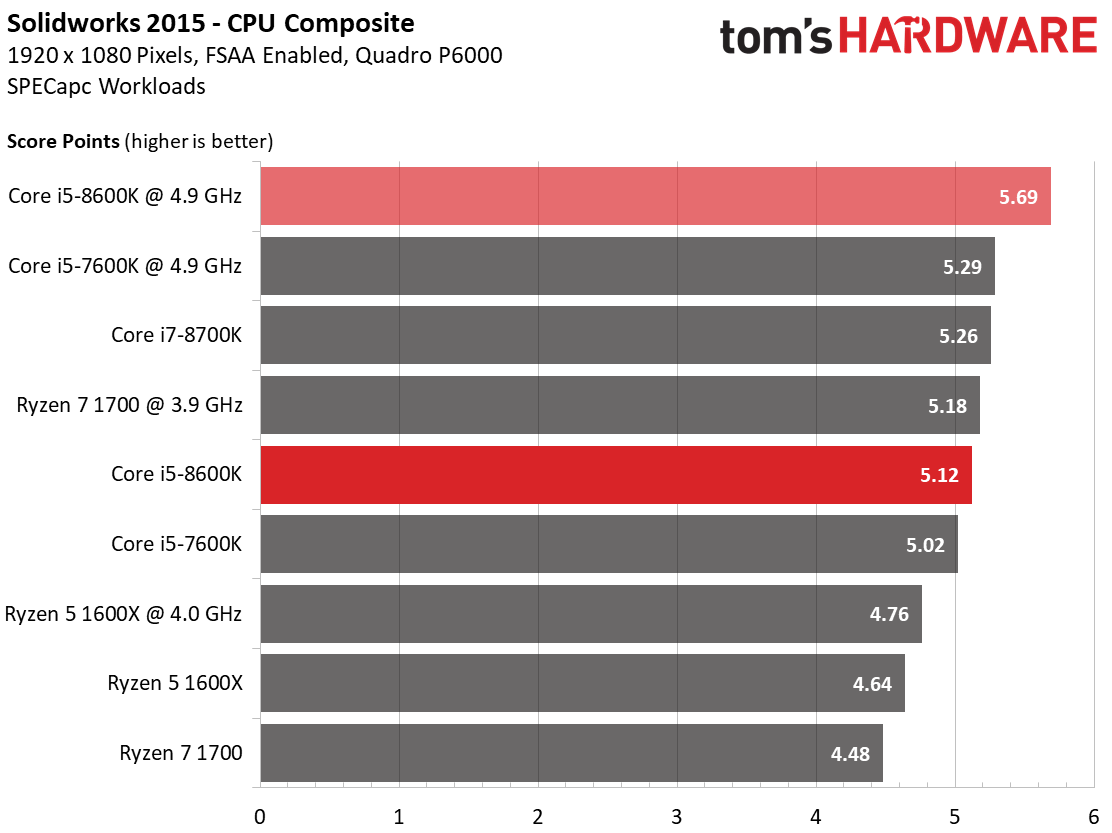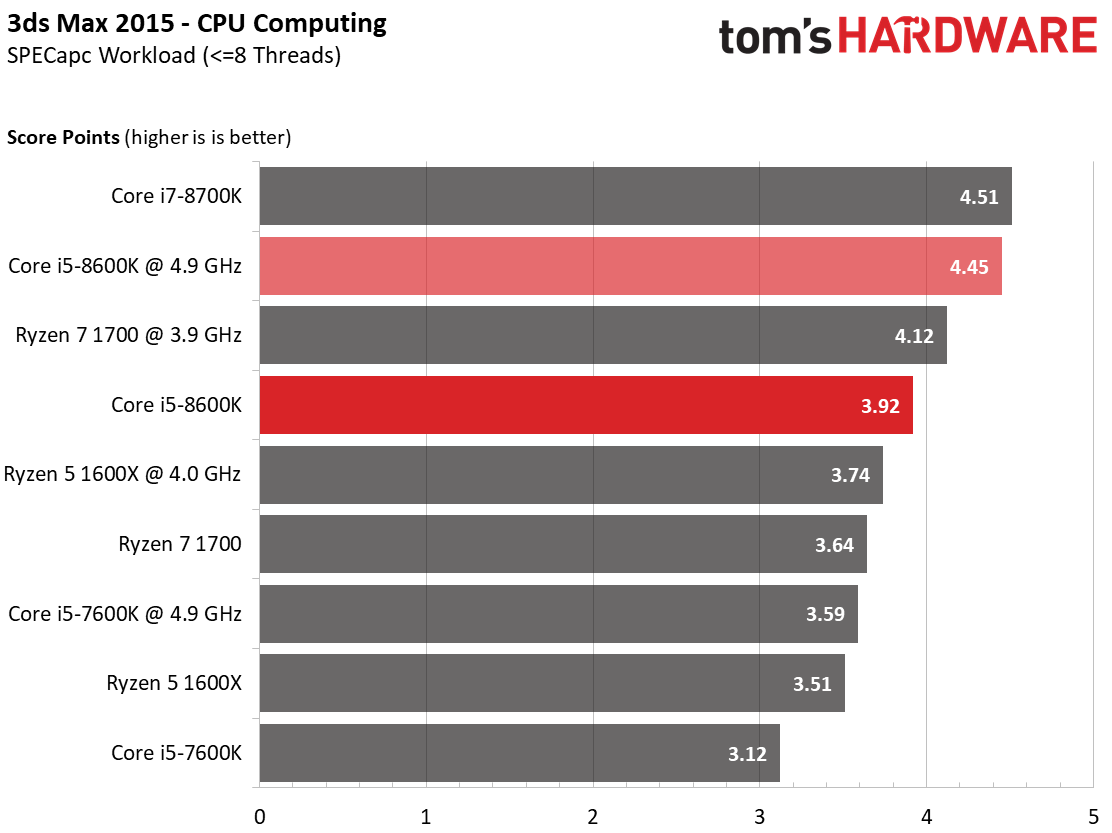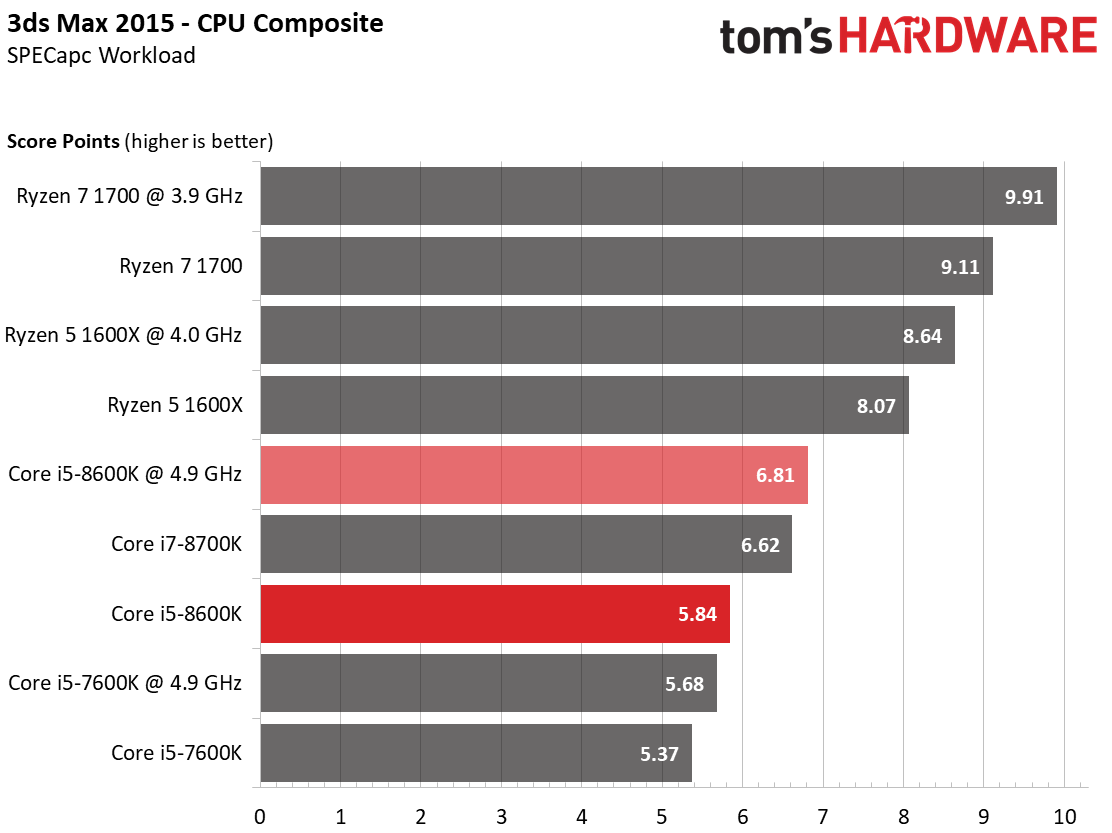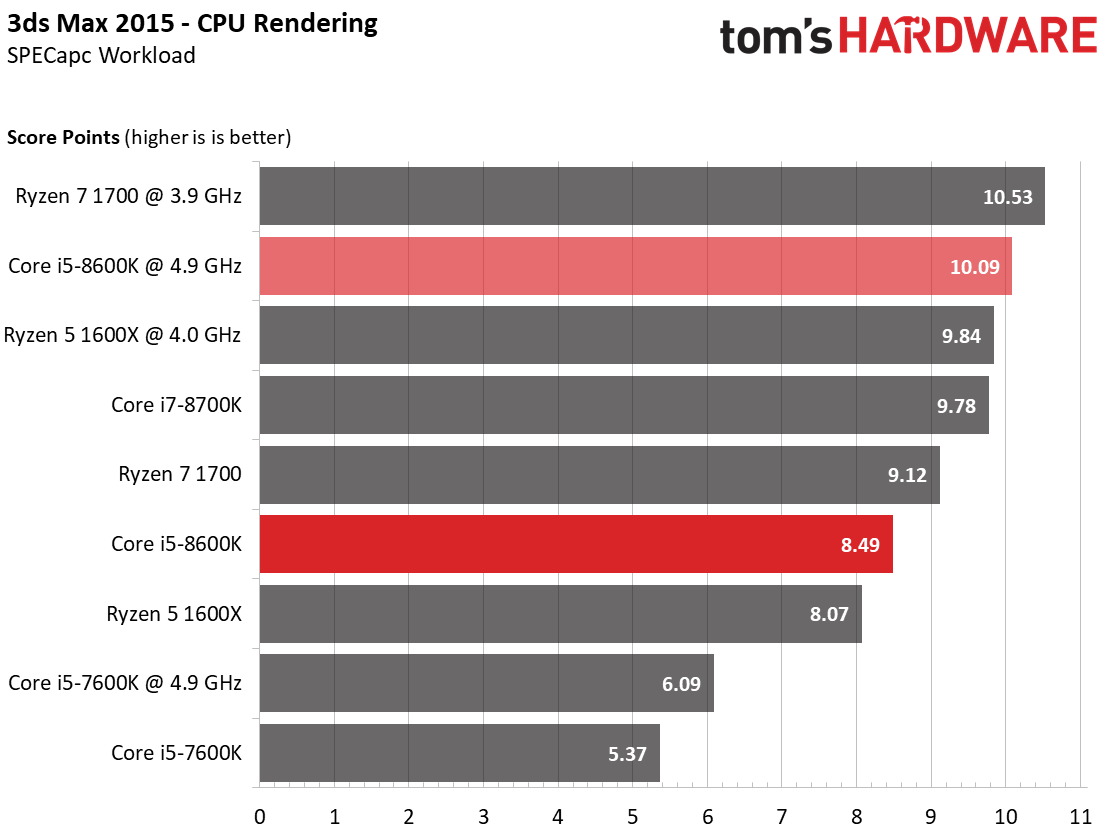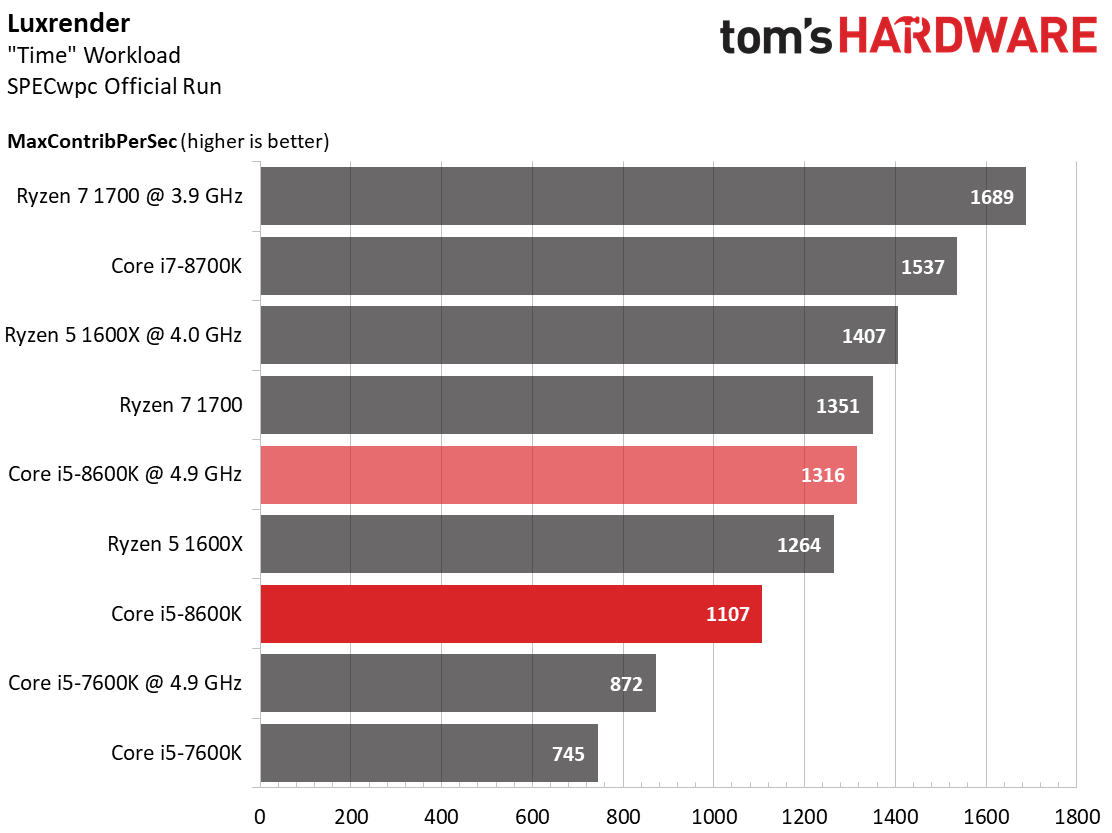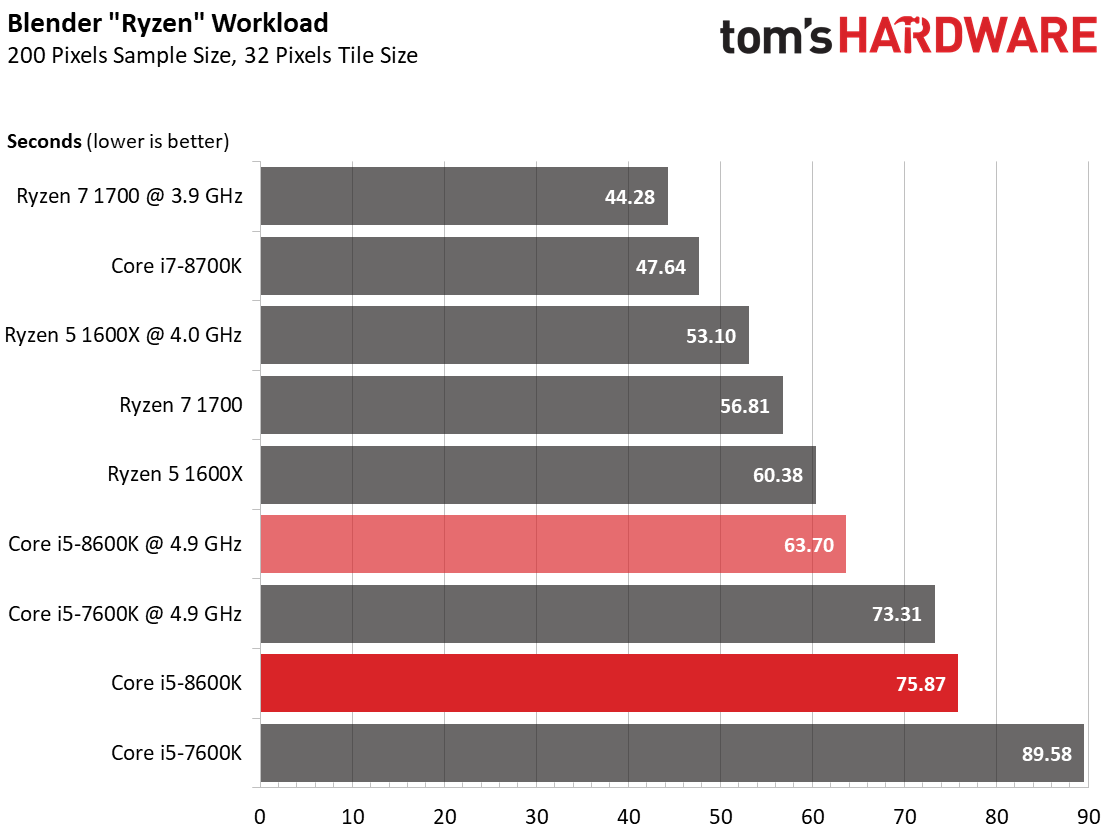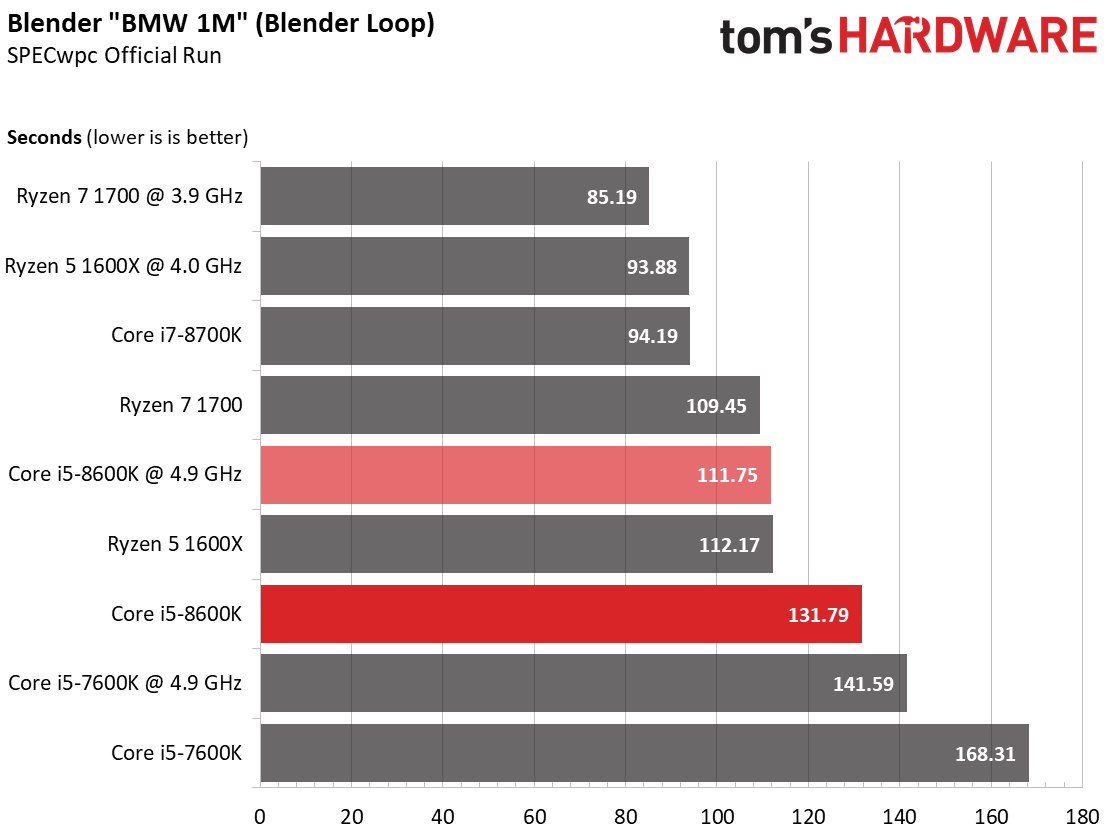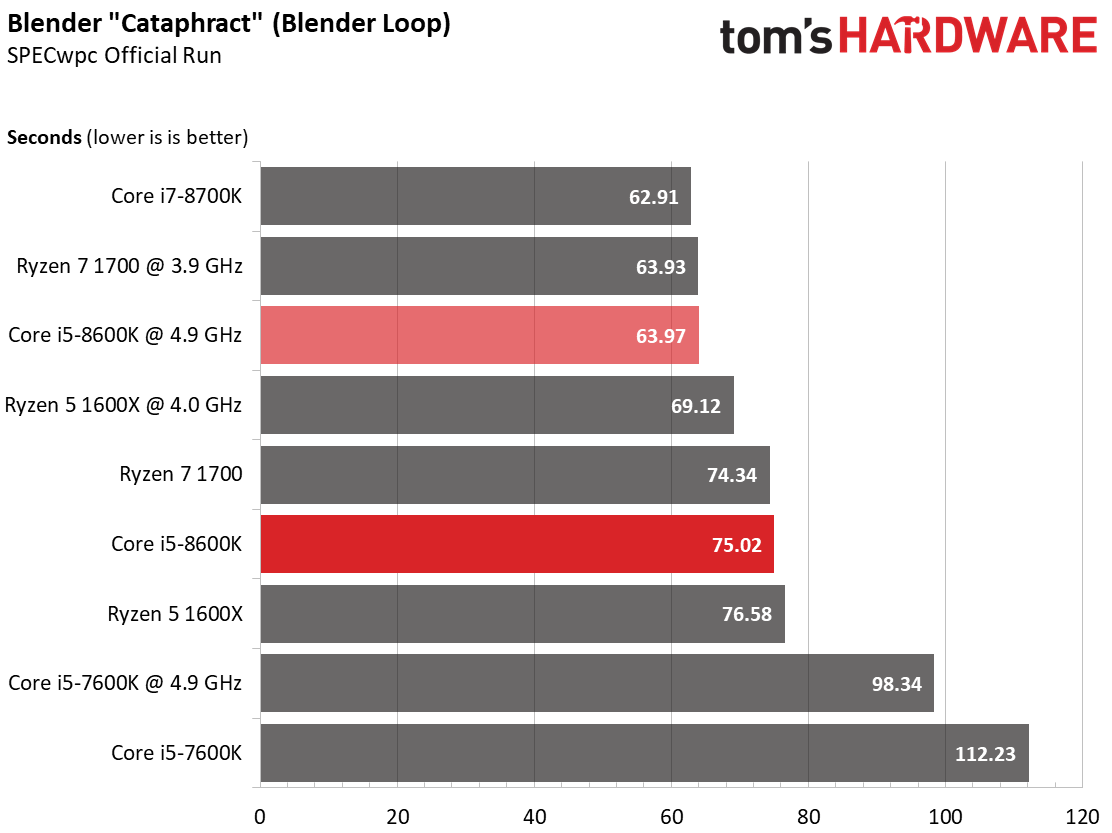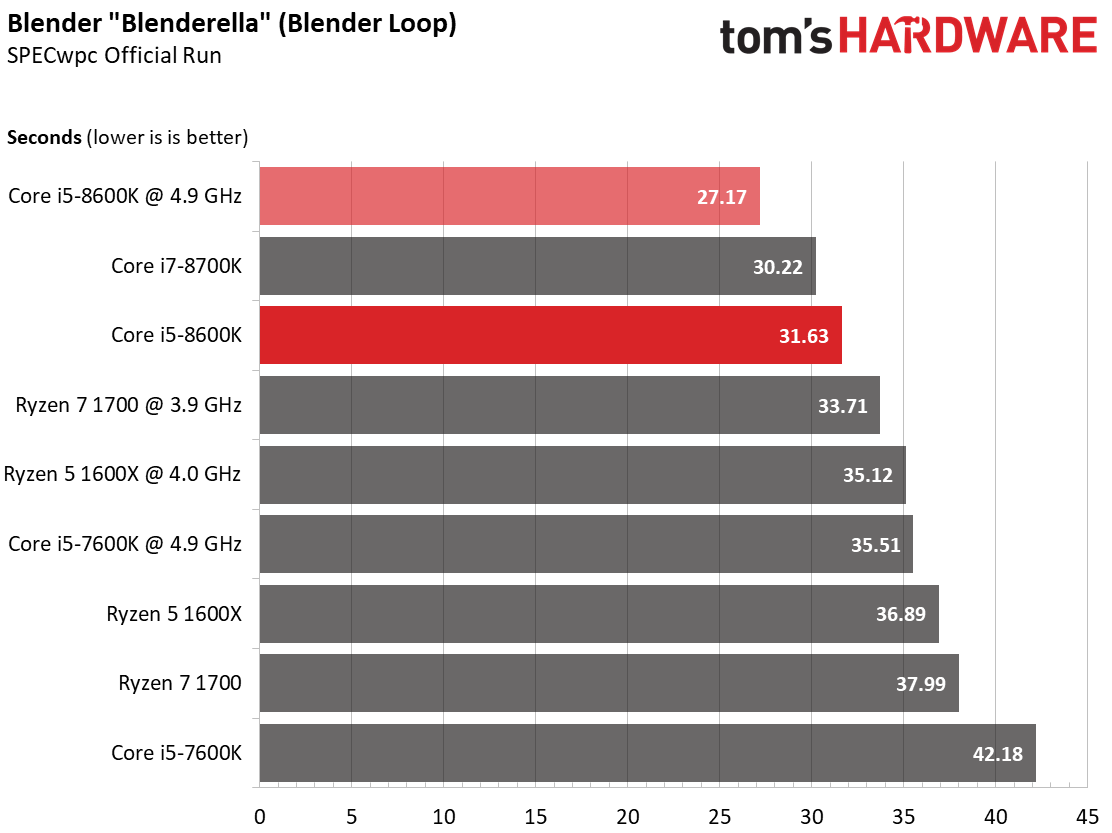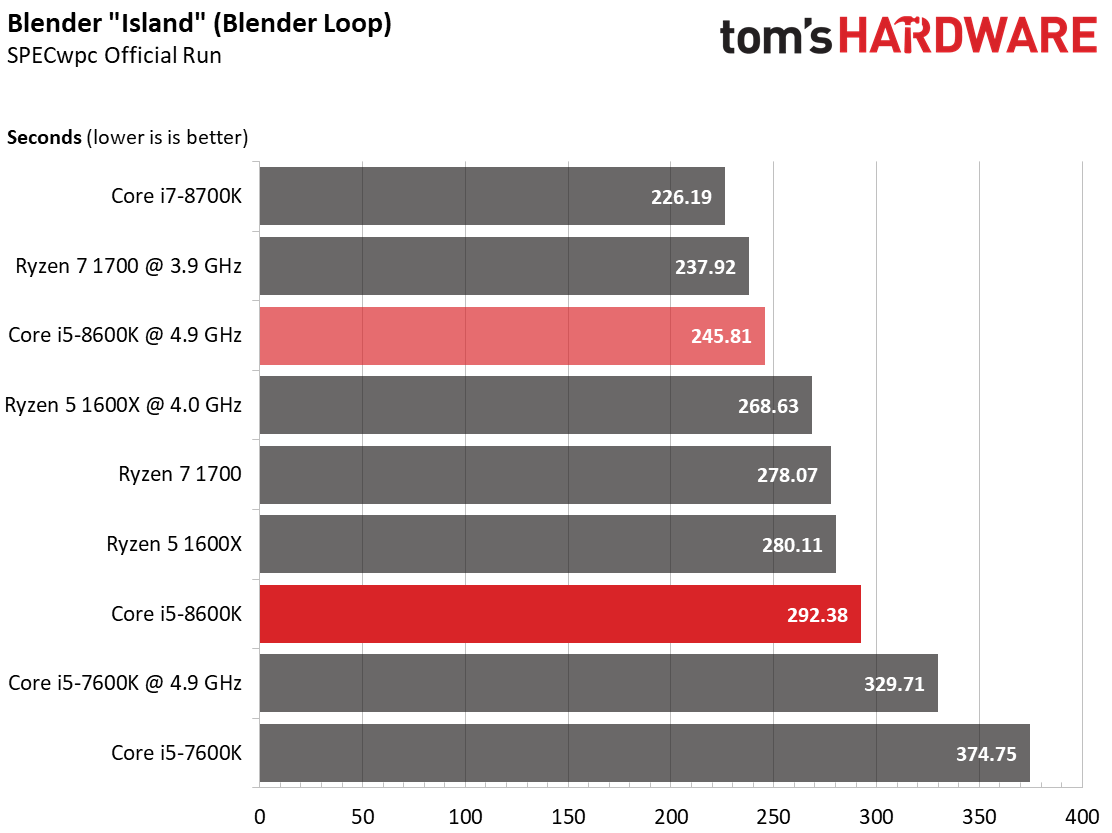Intel Core i5-8600K Review: Coffee Lake's Jolting Value
Why you can trust Tom's Hardware
CPU Computing & Rendering Performance
CPU Performance: Workstation
Many modern suites include modules that are based exclusively on computing and simulations. This means we need to go beyond just 3D workstation performance to form our opinion of these high-end CPUs. However, software packages like SolidWorks don’t scale perfectly based on core/thread count. Consequently, even quad-core processors keep up if they run at high-enough frequencies and support SMT. We'll illustrate this by comparing Core i5-7600K to the newer -8600K, which benefits from more cores and cache.
Frequency is all that counts in Creo 3.0. Intel's Core i5-8600K can't do anything with its two extra cores; the -7600K is right behind on our chart. Cranking the clock rate up to 4.9 GHz, on the other hand...
Clock rate and core count both matter in 3ds Max 2015, allowing Intel’s Core i5-8600K to pull ahead of the -7600K by a larger margin.
The CPU composite score includes rendering, which is broken out into its own section below. There, AMD's Ryzen 7 does well, becoming the value champion to beat.
CPU Performance: Photorealistic Rendering
Final rendering doesn’t require a CPU that's good at everything. Rather, this task wants efficiency and fast parallel computation.
In pure rendering, Core i5-8600K is at the top of its class. However, you can see how AMD's Ryzen 7 1700 benefits a ton when its eight cores are overclocked. Thread count takes precedence over frequency, but performance does scale beautifully with the latter.
Core i7-8700K bests Ryzen 7 1700 at stock clock rates. Overclocking shoots AMD's affordable 8C/16T solution up to the front of our chart, though.
Get Tom's Hardware's best news and in-depth reviews, straight to your inbox.
Intel's new Core i5 suffers somewhat due to its lack of Hyper-Threading. However, a 4.9 GHz clock rate certainly helps the six-core CPU compensate.
Last, but not least, we take a look at Blender. The usual workload (with a sample size of 200 pixels) confirms what we saw in the preceding benchmarks: Core i5-8600K trails the notably less expensive Ryzen 5 1600X.
The results obtained from SPECwpc’s Blender loop look similar, even though this benchmark presents a somewhat different task consisting of more than just rendering.
With the workload's rendering portion easing up, a stock Core i7-8700K suddenly becomes more competitive.
This trend intensifies as our benchmark begins incorporating tasks other than photorealistic rendering. Core count isn't the sole determiner of performance; IPC throughput factors in as well. That's why you see older quad-core models with SMT rise through the ranks. The tuned Core i5-8600K even takes the top spot.
In this test, the new Core i7-8700K and overclocked Ryzen 7 1700 lead. Core count matters, of course, but operating frequency is also a critical variable.
Intel’s Core i5-8600K offers acceptable performance in semi-professional applications; it's not just a gaming CPU. It's lack of Hyper-Threading support does show in threaded workloads, though. This keeps the Core i5 from dating above its league. If the chip performed too well, it'd cannibalize sales of pricier Core i7 models.
Going up against AMD isn't easy, though. The Ryzen processors fare well in stock form, and then respond readily to our overclocking efforts.
MORE: Best CPUs
MORE: Intel & AMD Processor Hierarchy
MORE: All CPUs Content
Current page: CPU Computing & Rendering Performance
Prev Page Workstation 2D & 3D Performance Next Page Scientific & Engineering Computations, HPC Performance
Paul Alcorn is the Editor-in-Chief for Tom's Hardware US. He also writes news and reviews on CPUs, storage, and enterprise hardware.
-
logainofhades Great CPU, but the overall platform cost is a bit of a turn off, for me. I'd rather get a 1600, and a B350 board, to allow for a better GPU, if buying new. As stated in the review, even a 1700, with a less expensive board, is a very compelling option.Reply
-
AS118 Seems like a good product, but I'd like to see what the 8600 and 8500 non-k offers, and perhaps next year with the B360 boards that give them a more budget "locked cpu" option.Reply
I also feel that the availability will be low for Coffee Lake until the end of this year, particularly throughout the holiday season. Due to that concern (as well as the total cost of platform ownership) I think that Ryzen with its 1600 and 1700 CPU's along with the 1600x will be the value kings this year, with Coffee Lake not hitting it's stride until early next year.
The fact that AMD's stuff doesn't have the same availability issues makes it a strong contender, imho, although Black Friday and Christmas sales will also like make Kaby Lake (and even Sky Lake) stuff at clearance prices appealing too, despite the lack of cores you'll find in Ryzen and now Coffee Lake. -
almostdecent Since the chart shows the i5-8600k and the i5-8600K@4.9GHz at the same $260, I presume that means you achieved the overclock with the stock cooler.Reply -
ammaross It's kind of disappointing to see so many benchmarks where an i5 does as well or better than it's i7 counterpart. It just shows how poorly threaded some of these applications really are and almost necessitates running two benchmarks simultaneously to really judge the merit of these multi-core CPUs. Maybe run the photoshop test while rendering with After Effects or run a game benchmark while doing CPU h.265 handbrake.Reply -
almostdecent It is worth mentioning that this is essentially a paper launch at the moment, since none of the Coffee Lake processors are available anywhere.Reply
http://www.nowinstock.net/computers/processors/intel/
and the rare place that has any, such as Microcenter, have gouging prices. Such as selling the plain i7-8700 (not the K version) with an MSRP of $300 for sale for $429.
http://www.microcenter.com/product/486087/Core_i7-8700_Coffee_Lake_32_GHz_LGA_1151_Boxed_Processor -
InvalidError Reply
On September 20, Intel responded to a story about yet another 10nm schedule slip by saying that Cannon Lake will begin shipping in limited quantities to some laptop manufacturers with production ramping up in 1H2018. Limited Coffee Lake volume could be due to Intel deciding to upgrade production lines to 10nm for Cannon Lake instead of 14++.20281291 said:I also feel that the availability will be low for Coffee Lake until the end of this year, particularly throughout the holiday season. -
TJ Hooker Reply
Not sure if you were being sarcastic, but the 8600K doesn't have a stock cooler.20281420 said:Since the chart shows the i5-8600k and the i5-8600K@4.9GHz at the same $260, I presume that means you achieved the overclock with the stock cooler.
There are two different sets of graphs, one that looks at CPU only costs and the other that considers CPU, mobo, and cooler costs. In the latter, the 8600K at 4.9GHz is clearly shown to cost more.
-
InvalidError Reply
Intel hasn't included a stock HSF with their unlocked CPUs since Skylake so on top of paying more for the unlock, you also get shafted by the price of a stock cooler which you no longer get on top of it. You need an aftermarket cooler for both stock and OC.20281420 said:Since the chart shows the i5-8600k and the i5-8600K@4.9GHz at the same $260, I presume that means you achieved the overclock with the stock cooler.
Same thing with AMD's Ryzen nnnnX CPUs. -
YoAndy Reply20281216 said:Great CPU, but the overall platform cost is a bit of a turn off, for me. I'd rather get a 1600, and a B350 board, to allow for a better GPU, if buying new. As stated in the review, even a 1700, with a less expensive board, is a very compelling option.
A better GPU?//Why would you do that. at 1080p Ryzen will (bottleneck) hold back powerful GPU's, It won't give you equal performance. I bought a Ryzen for pure gaming and i ended up selling it.. -
acosta.87 Reply20281216 said:Great CPU, but the overall platform cost is a bit of a turn off, for me. I'd rather get a 1600, and a B350 board, to allow for a better GPU, if buying new. As stated in the review, even a 1700, with a less expensive board, is a very compelling option.
B350 VRM's are pretty low quality for any sort of OC unless it's a mild one so for me that's a no go. If you're primarily into gaming then the 1600 has nothing on the i5, it simply trails it whether at stock settings or OC'd and even at productivity it beats a 1600 Ryzen processors in most task even with a 6 thread deficit so it's a pretty good investment overall.
